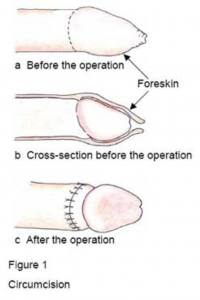Circumcision Adult
This means removing foreskin surgically. The exact surgical  techniques may depend on the reason for surgery, but the principles are described below.Under a local, regional or general anaesthetic, the foreskin is freed from any adhesions to the head of the penis, and then a cut is made on the top surface of the foreskin to the level at which the foreskin will be removed.The foreskin is trimmed away with scissors and every bleeding point picked up with the fine clips and tied off. The skin and inner covering (mucosa) are sutured together using a few absorbable sutures.
techniques may depend on the reason for surgery, but the principles are described below.Under a local, regional or general anaesthetic, the foreskin is freed from any adhesions to the head of the penis, and then a cut is made on the top surface of the foreskin to the level at which the foreskin will be removed.The foreskin is trimmed away with scissors and every bleeding point picked up with the fine clips and tied off. The skin and inner covering (mucosa) are sutured together using a few absorbable sutures.
RISKS
These are the commoner risks. There may be other unusual risks that have not been listed here. Please ask you surgeon if you have any general or specific concerns.
There are risks associated with any anaesthetic, you may have side effects from any drugs used. The commoner side effects include light-headedness, nausea, skin rash and constipation.
A circumcision has the following specific risks and limitations:
- Bleeding from the wound may occur after the operation, which rarely may mean you have to return to theatre.
- Bruising or generalised swelling of the penis, which can take days to resolve.
- Infection of the wound itself, and you may need to take antibiotics for some time.
- If too little skin is removed, you may have skin tags. On the other hand, too much skin may be removed, you may have difficulties with erections.
- You may not like the cosmetic result.
- Rarely, the opening of my urethra (meatus) may be inadvertently injured during the operation. It may also become ulcerated and may heal with scarring, causing narrowing of the opening.
- You may notice some change in sensation during sexual intercourse.
- Any erections during the early post-operative period are likely to be painful and may cause the stitches to break. If this happens, the stitches may need to be replaced.
Some of the above risks are more likely if you smoke, are overweight, diabetic, have high blood pressure or have had previous heart disease.
When you are discharged, take care of the following:
- Medication to take home, must be completed
- For the initial 5 days following surgery, it is advised to shower or stand in the bath in order to prevent premature dissolving of suture material
- Cover/waterproof the dressing in order to not get the dressing wet
- The dressing should be left in place as per doctors’ orders
- If it were to come off before the 3 day period is up, no repeat dressing is usually necessary
- Ordinary soap and water together with normal hygiene care are all that is required
- If the dressing is difficult to remove after 3 days, sit in a bath of water for a short while
- Because the head of the penis has always been covered with skin, it my appear very irritated once the dressing is removed, this is normal and will improve over the coming weeks
- Continue with normal activities unless your doctor says otherwise
- Absorbable sutures are used, which can take around 2 weeks to start falling out. No sutures need removal (please do not remove them yourself)
- Please refrain from sexual intercourse or masturbation for 6 weeks following surgery
